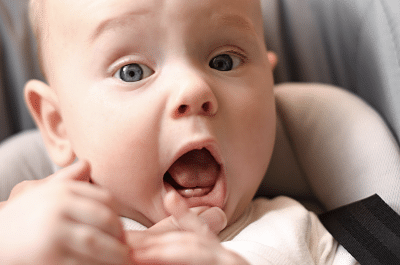
But getting through the discomfort of the teething process can be a trying time for both baby and parent. Interrupted sleep schedules, trouble eating and drinking, and just basic fussiness are no fun for anyone. There are, however, a number of ways to ease your baby’s teething distress.
Be Prepared: Common Signs that Your Baby is Teething
- Excessive drooling. While it’s true that all infants drool, you will likely notice a bit more than usual once teething begins. One telltale sign: the irritating effects of all that saliva may produce a rash or some chafing around the mouth.
- Unusual irritability. Does your little guy or girl seem especially cranky? While some lucky little ones may get through the process just fine, most will be out of sorts, especially at bedtime.
- Chewing. Teething babies may be constantly biting and chewing on everything or putting those tiny fingers or fist in their mouth to soothe their sore gums.
The Teething Process
The first teeth to appear will be the two bottom front, known as the lower central incisors. These will be followed by the four middle front teeth, the central and lateral incisors. About a month later, the two teeth flanking the bottom front teeth will appear, known as the lower lateral incisors. Next to appear are baby’s first molars, and then finally the pointy upper eyeteeth.
Teething Relief: Ways to Cope
If your teething baby is uncomfortable, there are a few easy methods to provide a bit of relief.
- Gently rub baby’s sore gums with a clean finger.
- Provide a teething ring or teething toy, chilled (but not frozen), or a chilled washcloth to bite down on. Make sure such items are large enough to prevent swallowing or choking and that there are no pieces that might break off.
- Ask your pediatrician about giving baby over-the-counter pain medications such as acetaminophen (like Tylenol) or ibuprofen ( Advil, Motrin).
But to keep baby safe, avoid teething medications containing benzocaine or lidocaine, and teething necklaces, bracelets or anklets, which present a risk of choking or strangulation. Dismiss the old wives’ tale of rubbing with whiskey or other alcohol.
When to call the doctor?
While teething may cause a slight increase in temperature, according to the Mayo Clinic, if your baby has a rectal temperature of 100.4 F (38 C) or diarrhea, contact your pediatrician. Something other than teething like an ear infection or a cold may be the cause.
Dental Care for Baby’s New Smile
It’s never too early to implement dental care. In fact, parents should clean infant mouths and gums regularly with a soft infant toothbrush or cloth and water.
Once that first tooth debuts, baby teeth should be brushed at least once a day. The American Academy of Pediatric Dentistry (AAPD) recommends using a soft-bristled toothbrush with a small head, preferably one designed for infants. Use a tiny amount of toothpaste—about the size of a rice kernel.
The AADP recommends that in order to prevent dental problems, your child should see a pediatric dentist when the first tooth appears, and no later than their first birthday. Schedule your child’s pediatric dental appointment with us at Wake Orthodontics & Pediatric Dentistry today!
